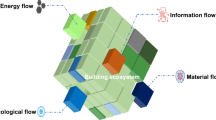Abstract
Landscape design for a green community should be favorable for the ambient ecological environment and for enhancement of both the local climate of a residential area and the environmental quality of life. This paper presents optimization methods for plant landscape design that take account of results of comparisons of noise reduction effects, heat island temperature decreases and effects on ventilation. These methods are based on different plant configurations and various luminous environments, such as exterior sunshine and shaded areas after the simulation of exterior luminous, acoustic and thermal environments of a residential area using the analytic software ECOTECT, CADNA/A, and PHEONICS. Three different types of residential buildings are simulated including a faculty apartment in the Xixi Campus of Zhejiang University, the Huaqing Villa and the Gangwan Jiayuan faculty apartment of Zhejiang University, China, based on green building design theory. In addition, the methods and process flow of landscape design of green residential areas are also described for the improvement of the exterior physical living environment.
Similar content being viewed by others
References
Architectural Science 205, 2007. Detailed Rules for Green Building Evaluation Technology (Trial Implementation). Science and Technology Department of the Construction Ministry, China (in Chinese).
Botequilha Leitao, A., Ahern, J., 2002. Applying landscape ecological concepts and metrics in sustainable landscape planning. Landscape and Urban Planning, 59(2):65–93. [doi:10.1016/S0169-2046(02)00005-1]
Chen, Z.X., Su, X.H., Liu, S.Z., Zhang, X.X., 1998. Beijing urban landscape ecological research. Journal of Chinese Landscape Architecture, 14(57):53–56 (in Chinese).
Ding, Y., 2008. Introduction to Landscape Design. Higher Education Press, Beijing, p.41–65 (in Chinese).
GB 3096-2008. Acoustic Environment Quality Standards. Ministry of Environmental Protection and General Administration of Quality Supervision, Inspection and Quarantine of the People’s Republic of China (in Chinese).
GB/T 50378-2006. Green Building Evaluation Standards. Establishment Section of Green Building Evaluation Standards, China (in Chinese).
Gidlof-Gunnarsson, A., Ohrstrom, E., 2007. Noise and well-being in urban residential environments: The potential role of perceived availability to nearby green areas. Landscape and Urban Planning, 83(2–3):115–126. [doi:10.1016/j.landurbplan.2007.03.003]
Giridharana, R., Lau, S.S.Y., Ganesan, S., Givoni, B., 2008. Lowering the outdoor temperature in high-rise high-density residential developments of coastal Hong Kong: The vegetation influence. Building and Environment, 43(10):1583–1595. [doi:10.1016/j.buildenv.2007.10.003]
Guangzhou Cuiting Horticulture Co., Ltd., 2009. Sun-loving and Shade-loving Plants. Available from http://www.gzctyy.com/fengshui/232.html [Accessed on Apr. 10, 2010] (in Chinese).
Guo, Z., 2005. The Research of Residential Outdoor Environment Design Based on “Health Housing”. MS Thesis, Beijing Forestry University, Beijing, China (in Chinese).
He, R., 2003. Analysis and Study into External Environment of the Xiao-kang Urban Houses of Northern Cities. MS Thesis, Xi’an Architecture and Technology University, Xi’an, China (in Chinese).
Huang, X.L., Wang, S.G., 1998. Research of urban living environment green amount (3)—research of green space quantitative function at home and abroad. Journal of Chinese Landscape Architecture, 14(57):57–59 (in Chinese).
Lin, X.D., 2007. Green Building—Eco Energy Reduce Waste, Health. China Building Industry Press, Beijing, p.52–78 (in Chinese).
Liu, J.N., 2007. Research on Noise Reduction Function of Landscape Plant. MS Thesis, School of Agricultural Biotechnology of Zhejiang University, Hangzhou, China (in Chinese).
Qiu, B.X., 2008. First International Intelligent and Green Building Technology Seminar, and the First International Intelligent and Green Building Technologies and Products Expo. Economic Herald, Aug., 21 (in Chinese).
Termorshuizen, J.W., Opdam, P., van der Brink, A., 2007. Incorporating ecological sustainability into landscape planning. Landscape and Urban Planning, 79(3–4): 374–384. [doi:10.1016/j.landurbplan.2006.04.005]
Tsinghua University, 2005. Tsinghua University Dashiqiao residential environmental design. Technology and Market (Landscape Engineer), (11):28–31 (in Chinese).
Tzoulas, K., Korpela, K., Venn, S., Vesa Yli-Pelkonen, V., Kazmierczak, A., Niemela, J., James, P., 2007. Promoting ecosystem and human health in urban areas using Green Infrastructure: A literature review. Landscape and Urban Planning, 81(3):167–178. [doi:10.1016/j.landurbplan.2007.02.001]
Wang, Q.Q., 2010a. Annual report: “green building 2010“. Construction Science and Technology, (6):20–21 (in Chinese).
Wang, Q.S., Wang, X.Y., Geng, A.F., 2007. Research for environmental planning value in green residential district. Journal of Harbin Institute of Technology, 39(12): 1984–1988 (in Chinese).
Wang, R.X., 2010b. Green building of low power consumption. Journal of Tianjin University (Social Science), 12(2): 144–148.
Wang, W., Liao, L., Fan, H.W., 2010. Low carbon economy green building technology development theory and practice. Construction Science and Technology, (6):38–40 (in Chinese).
Wu, D., Yuan, Y., 2010. Environmental protection and green building. Forestry Science and Technology Information, 42(1):24–26 (in Chinese).
Xue, M., 2010. Green building on the significance of protecting the environment safety. Journal of Xi’an Architecture and Technology University (Social Science), 29(1):47–52 (in Chinese).
Zhou, J.H., 1998. Research of urban living environment green amount (5)—research of three-dimensional green quantity and its application. Journal of Chinese Landscape Architecture, 14(59):61–63 (in Chinese).
Author information
Authors and Affiliations
Corresponding author
Additional information
Project (No. R1080363) supported by the Zhejiang Provincial Natural Science Foundation of China
Rights and permissions
About this article
Cite this article
Guo, Hf., Ge, J., Yue, M. et al. Landscape design method for a green community based on green building design theory. J. Zhejiang Univ. Sci. A 11, 691–700 (2010). https://doi.org/10.1631/jzus.A1000241
Received:
Accepted:
Published:
Issue Date:
DOI: https://doi.org/10.1631/jzus.A1000241




